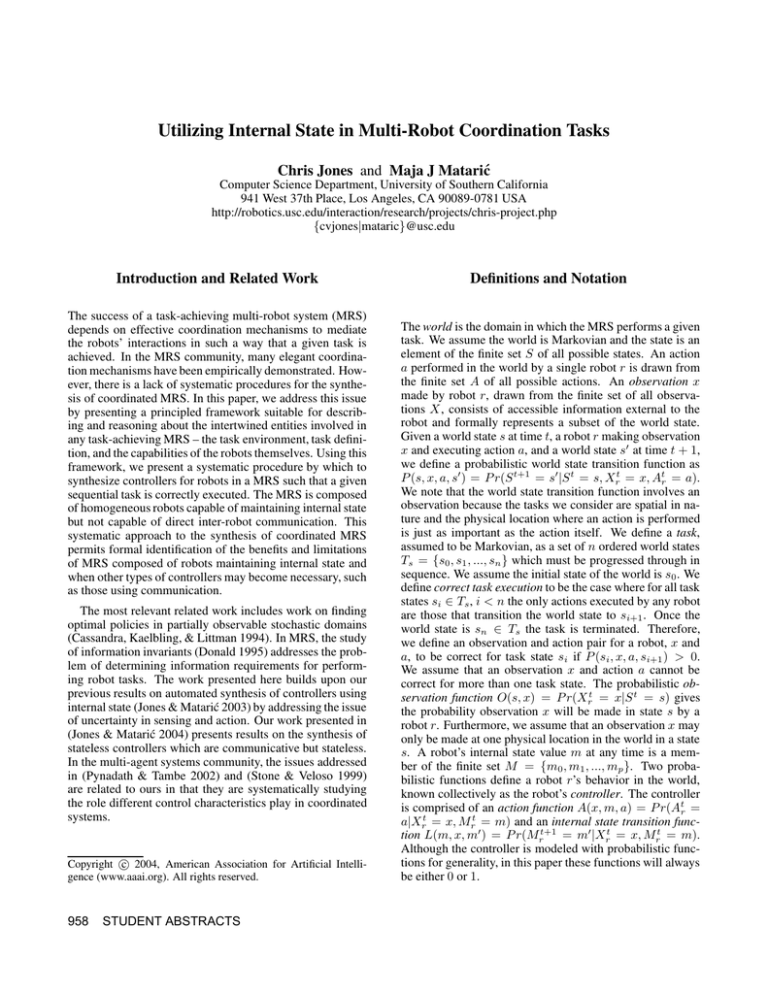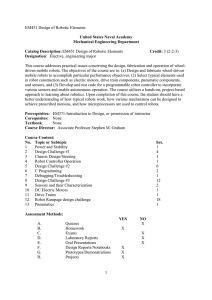
Utilizing Internal State in Multi-Robot Coordination Tasks
Chris Jones and Maja J Matarić
Computer Science Department, University of Southern California
941 West 37th Place, Los Angeles, CA 90089-0781 USA
http://robotics.usc.edu/interaction/research/projects/chris-project.php
{cvjones|mataric}@usc.edu
Introduction and Related Work
The success of a task-achieving multi-robot system (MRS)
depends on effective coordination mechanisms to mediate
the robots’ interactions in such a way that a given task is
achieved. In the MRS community, many elegant coordination mechanisms have been empirically demonstrated. However, there is a lack of systematic procedures for the synthesis of coordinated MRS. In this paper, we address this issue
by presenting a principled framework suitable for describing and reasoning about the intertwined entities involved in
any task-achieving MRS – the task environment, task definition, and the capabilities of the robots themselves. Using this
framework, we present a systematic procedure by which to
synthesize controllers for robots in a MRS such that a given
sequential task is correctly executed. The MRS is composed
of homogeneous robots capable of maintaining internal state
but not capable of direct inter-robot communication. This
systematic approach to the synthesis of coordinated MRS
permits formal identification of the benefits and limitations
of MRS composed of robots maintaining internal state and
when other types of controllers may become necessary, such
as those using communication.
The most relevant related work includes work on finding
optimal policies in partially observable stochastic domains
(Cassandra, Kaelbling, & Littman 1994). In MRS, the study
of information invariants (Donald 1995) addresses the problem of determining information requirements for performing robot tasks. The work presented here builds upon our
previous results on automated synthesis of controllers using
internal state (Jones & Matarić 2003) by addressing the issue
of uncertainty in sensing and action. Our work presented in
(Jones & Matarić 2004) presents results on the synthesis of
stateless controllers which are communicative but stateless.
In the multi-agent systems community, the issues addressed
in (Pynadath & Tambe 2002) and (Stone & Veloso 1999)
are related to ours in that they are systematically studying
the role different control characteristics play in coordinated
systems.
c 2004, American Association for Artificial IntelliCopyright gence (www.aaai.org). All rights reserved.
958
STUDENT ABSTRACTS
Definitions and Notation
The world is the domain in which the MRS performs a given
task. We assume the world is Markovian and the state is an
element of the finite set S of all possible states. An action
a performed in the world by a single robot r is drawn from
the finite set A of all possible actions. An observation x
made by robot r, drawn from the finite set of all observations X, consists of accessible information external to the
robot and formally represents a subset of the world state.
Given a world state s at time t, a robot r making observation
x and executing action a, and a world state s0 at time t + 1,
we define a probabilistic world state transition function as
P (s, x, a, s0 ) = P r(S t+1 = s0 |S t = s, Xrt = x, Atr = a).
We note that the world state transition function involves an
observation because the tasks we consider are spatial in nature and the physical location where an action is performed
is just as important as the action itself. We define a task,
assumed to be Markovian, as a set of n ordered world states
Ts = {s0 , s1 , ..., sn } which must be progressed through in
sequence. We assume the initial state of the world is s0 . We
define correct task execution to be the case where for all task
states si ∈ Ts , i < n the only actions executed by any robot
are those that transition the world state to si+1 . Once the
world state is sn ∈ Ts the task is terminated. Therefore,
we define an observation and action pair for a robot, x and
a, to be correct for task state si if P (si , x, a, si+1 ) > 0.
We assume that an observation x and action a cannot be
correct for more than one task state. The probabilistic observation function O(s, x) = P r(Xrt = x|S t = s) gives
the probability observation x will be made in state s by a
robot r. Furthermore, we assume that an observation x may
only be made at one physical location in the world in a state
s. A robot’s internal state value m at any time is a member of the finite set M = {m0 , m1 , ..., mp }. Two probabilistic functions define a robot r’s behavior in the world,
known collectively as the robot’s controller. The controller
is comprised of an action function A(x, m, a) = P r(Atr =
a|Xrt = x, Mrt = m) and an internal state transition function L(m, x, m0 ) = P r(Mrt+1 = m0 |Xrt = x, Mrt = m).
Although the controller is modeled with probabilistic functions for generality, in this paper these functions will always
be either 0 or 1.
Principled Controller Synthesis
Leveraging the formalism presented above, Figure 1
presents a controller synthesis procedure consisting of four
phases. The first phase (lines 2-3) synthesizes an action
function for a baseline stateless controller which contains
a rule for each action in the task, but there is no guarantee
the task will be performed in the correct sequence.
The second phase (lines 4-6) initializes some relevant
variables. The variable Xa (si ) contains the set of all observations x for which there exists an action a such that x
and a are correct for state si , for all si ∈ Ts . The set Va (si )
will contain the index of the internal state value (i.e., 0 represents m0 ) that a robot will need to have in order to execute
an action in state si , for all si ∈ Ts . Initially, all values in
Va are assigned the same internal state value m0 – this is
equivalent to not using any internal state at all. Lastly, the
set Oa (si ) will contain the observation, if any, that will be
used to transition the internal state value in state si , for all
si ∈ Ts . Initially, all values in Oa are N U LL as no internal
state transitions are defined at this point.
The third phase (lines 7-12) identifies situations in which
internal state can be used to improve coordination and assigns appropriate values to the sets Va and Oa . The basis
for determining when internal state can be used to improve
coordination is in identifying task states where an observation x in Xa (sj ), where x and some action a are correct for
sj , can also be made in some earlier task state si for which
x and a are not correct. We note that our synthesis method
does not deal with the situation where there exists a task
state sp which occurs later than sj and O(sp , x) > 0, where
x and a are not correct for sp .
The fourth phase (lines 13-18) synthesizes the final controller by augmenting the stateless controller synthesized in
the first phase. This is accomplished by adding the internal
state transition function and appropriately modifying the action function such that an action is not executed unless the
robot’s current internal state value is appropriate. The internal state transition function is constructed (lines 14-15)
by mapping the internal state value mVa (si )−1 and observation Oa (si ) to the next internal state value of mVa (si ) , for all
si ∈ Ts . The action function is modified (lines 16-17) such
that for each rule of the action function A(x, m0 , a) = 1
where x and a are correct for a state si is modified to become A(x, mVa (si ) , a) = 1, where mVa (si ) is the required
internal state value for task state si as determined in the third
phase. All probabilities not explicitly declared are 0.
Experimental Validation
We experimentally validate our controller synthesis procedure in a multi-robot construction domain, through extensive physically-realistic simulations and on a limited set of
real-robot experiments. The construction task requires the
sequential placement of a series of cubic colored bricks into
a planar structure. Each robot’s sensing capabilities limit it
to sensing only a limited profile of the current construction
at any given time. Additional details on the multi-robot construction domain can be found in (Jones & Matarić 2004).
We performed 300 experimental trials in simulation for
(1) procedure Synthesize Controller()
(2) for all si ∈ Tx , a ∈ A, x ∈ X(O(si , x) > 0 ∧ P (si , x, a, si+1 ) > 0) do
(3)
A(x, m0 , a) = 1
(4)
(5)
(6)
for all si ∈ Ts do
Xa (si ) = {x0 , x1 , ..., xn } s.t. ∀x ∈ Xa (si )∃a(O(si , x) > 0
∧A(x, m0 , a) = 1)
Va (si ) = 0; Oa (si ) = N U LL
(7) for all si , sj ∈ Ts (i < j) do
(8)
if ∃x ∈ Xa (sj )(O(si , x) > 0) then
(9)
for sk = sj downto si+1 do
(10)
if ∃z@su (O(sk , z) > 0 ∧ u < (i + 1) ∧ O(su , z) > 0) then
(11)
Oa (sk ) = z
(12)
∀sw (w >= k) → Va (sw ) = Va (sw ) + 1
(13) for all si ∈ Ts do
(14)
if Oa (si ) 6= N U LL then
(15)
L(mVa (s )−1 , Oa (si ), mVa (s ) ) = 1
i
i
(16)
for all x ∈ Xa (si ), a ∈ A(A(x, m0 , a) = 1) do
(17)
A(x, m0 , a) = 0; A(x, mVa (s ) , a) = 1
i
(18) end procedure Synthesize Controller
Figure 1: Controller synthesis procedure.
a specific construction task made up of 7 bricks. The synthesized controller correctly executed the construction task
in 31.5% of the trials. We note that there exists significant
uncertainty in sensing and imperfect actions, and in the absence of such uncertainties, the synthesized controller would
be gauranteed to correctly execute the task. For comparison,
the stateless controller from the first phase of the synthesis procedure resulted in only 0.9% of the trials resulting
in correct task execution. A limited number of successful
real-robot experiments were performed to verify that any assumptions we made are reasonable and realistic. The experiments were also performed to show that our formalism and
synthesis method are not merely abstract concepts but have
been successfully implemented on real systems and capture
the difficult issues involved in real-world embodied MRS.
References
Cassandra, A.; Kaelbling, L. P.; and Littman, M. 1994.
Acting optimally in partially observable stochastic domains. In Proceedings of the Twelfth National Conference
on Artificial Intelligence, 1023–1028.
Donald, B. R. 1995. Information invariants in robotics.
Artifical Intelligence 72(1–2):217–304.
Jones, C., and Matarić, M. 2003. Towards a multi-robot
coordinaton formalism. In Proc. of the Workshop on the
Mathematics and Algorithms of Social Insects, 60–67.
Jones, C., and Matarić, M. 2004. Communication in multirobot coordination. Technical report, University of Southern California Center for Robotics and Embedded Systems,
CRES-04-001.
Pynadath, D., and Tambe, M. 2002. Multiagent teamwork: Analyzing the optimality and complexity of key theories and models. In International Joint Conference on Autonomous Agents and Multi-Agent Systems, 873–880.
Stone, P., and Veloso, M. 1999. Task decomposition,
dynamic role assignment, and low-bandwidth communication for real-time strategic teamwork. Artificial Intelligence
110(2):241–273.
STUDENT ABSTRACTS 959



